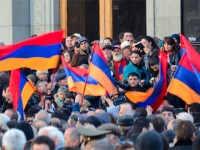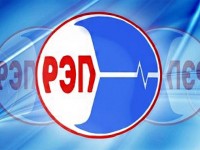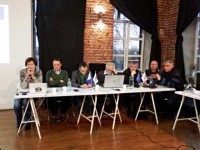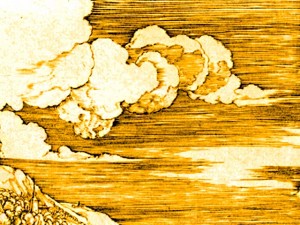The Belarusan National Platform of the EaP CSF issued a statement in connection with the wave of searches in the editorial offices of the Belarusan media and the detention of journalists.
Dominants of Belarusan culture in the narrative of Michal Aniempadystau (Photo)

What is culture based on and what is nation based on?
Within the frames of the Flying University “The main question”  a fifth lecture took place. EuroBelarus Information Service asked Michal Aniempadystau, designer and cultural actor, what did he mean by calling the lecture “Imagining Belarus”
a fifth lecture took place. EuroBelarus Information Service asked Michal Aniempadystau, designer and cultural actor, what did he mean by calling the lecture “Imagining Belarus”  .
.
The imagined community is the term that Benedict Anderson introduced in relation to a nation. He argues with the model that the “nation arises in result of historical circumstances”. Anderson explained that it is not enough. Even if there are historical preconditions a nation doesn’t arise as a community. We are not a community, but we think of ourselves as a community. This image should be unified and happens with the emotional experience. If a certain group of people starts thinking of itself as a community, as a unity, then a nation arises. If there are no preconditions, a community cannot arise:
“Considering the history of Belarusan nation’s building, we involuntarily note that Anderson was right,” noted Michal Aniempadystau.
According to the American historian Timothy D. Snyder, Belarusans had the better conditions in Polish-Lithuanian Commonwealth than the Polish, since they had huge territory and no language barrier. However, despite all the objective factors the nation didn’t arise. Snyder says that this is because no attractive model of a nation was created.
In Belarus many people faced the fact that when we are talking about Belarusan culture then contradicting visions appear. According to Anderson model, it’s insane; there can be no different images inside one community:
“What is a national culture? It’s a culture the values of which don’t require additional argumentation inside one community. A Lithuanian, a Polish, and a Russian don’t need to prove their value.”
According to Amnepadystau, we imagine ourselves extremely precisely and critically and are well aware of our disadvantages. Besides, our “collective mind” takes into account the external, tendencies, and political situation — everything that is happening around. And when imagining ourselves, the community also actualizes itself, too.
When we have an image of ourselves and when we actualize it, we see our future.
Actualization of such a big group of people as a nation is happening in the form of political moves; politics is a continuation of culture. And when a national state arises then the issues of language preservation, historical legacy, and knowledge transfer are resolved. The state is interested in preserving the national language; it gives it an official status. But the language doesn’t coincide with the borders of the country, and the borders of the country do not coincide with the borders of represented culture and community.
The culture expert says that there are two different cultural models at the Belarusan territory at the same time. One is built at the principle of continuity; the other one is post-Soviet and is a surprising mix of Soviet, Russian ideology (non-imperial and what there was in the 19th century), and Belarusan ideology. This mix is non-appealing because it is unstable to external challenges and non-competitive. It starts collapsing to “Orthodoxy”, “Russian World”, and other. Since both the groups are Belarusans, two absolutely different images arise; two cultural models, two languages, and two visions of the future. On the other hand, inside the Belarusan community there is no agreement either since there is no well-thought system re language policy, education, etc.:
“Or it is our immaturity as a nation. What do we believe to be a nation? Is it an imagined community or are these contradicting constructions within the frames of the country that are also sometimes hostile to the existence of Belarusianism (which I find absolutely absurd)? It is an open question.”
Michal Aniempadystau marked out several values or dominants of Belarusan culture.
One of them is a historical continuity. Any culture starts from something; we cannot construct culture since it is not an instinct, it is the accumulation and transition of knowledge. From which we conclude that everything that happened at the Belarusian territory is Belarusan culture, including events that were happening in the Soviet Union. As to the Soviet system, since the seizure of power happened, the community had nowhere to go and that’s why it was Sovietized. However, the fact of this community’s existence was taken into account even by the occupation authorities. However, after the war the core of Belarusianism started to appear in Soviet institutions.
The other dominant of Michal Aniempadystau: Belarusan culture model has appeared as an ethnical model. The Polish nation arose at the Belarusan territory and it first was political. Later local patriotism appeared at this Polish culture field, which revealed itself in Lithuanianism. This is the first ethnic identification, which was considered to be a “younger brother” of the Polish culture. That’s why the image of “poor Belarusans” arose:
“Tearing the roots and “transplanting” a person to a different soil can change this person into a representative of a different culture, which was happening all the time during the 20th century. If it wasn’t for the Russian empire then a Belarusan nation wouldn’t have arisen — a Polish model would be forming further on so we would be speaking Polish now,” noted the lecturer.
Apart from the Polish, the Jewish nation also arose at the Belarusan territory.
Michal Aniempadystau suggests taking the period of “Nasha Niva” (literally “Our field”; a newspaper that is one of the oldest Belarusian weekly newspapers founded in 1906. — EuroBelarus IS). Further — BSSR and the Polish rule. One more important landmark is the World War II. Since the Civil War of 1920s wasn’t a civil war for Belarusans they took part in it fragmentarily.
Now Belarusan nation isn’t ethnical. Moreover, since it isn’t ethnical the background of the Belarusan culture should also include the Polish, Jewish, Tatar, Old Believers, and Calvinist cultures...
Next dominant is tolerance, not as a character trait but as a sense of justice, which is realized in the form of lawmaking. One more thing is localness, which created problems at a certain moment of time. But this is also a cultural distinctness, which has deep roots and connection to colonization of Belarusan land. From that we can conclude that the space is splintered.
Traditional democracy is typical for Belarusans. Search for political forms of community actualization has always had democratic character. And no extremist movements have never emerged in the newest time. Extremism is not our tradition.
After that comes Europeanism. Belarusan culture emerged thanks to the presence in the European cultural field.
Non-religiousness or flexible religiousness: we witness the transfer from one religion to the other everywhere and no one asks any questions.
And the last one is Belarusian-centrism. We view Belarus as a center of the World and understand the World as a place of our presence:
“I have an impression that over the last couple of years in relation to the Ukrainian events actualization of Belarusan community is taking place. Perhaps, Anderson is right — the community should actualize itself.”
Others
-
Statement of the Belarusan EaP CSF National Platform on solidarity with the civil society of Armenia
The Belarusan National Platform of the Eastern Partnership Civil Society Forum issued a statement on solidarity with the civil society of Armenia.
-
Statement of the BNP in connection with the criminal prosecution of the leaders of the Belarusan independent trade unions
The Belarusan National Platform of the Eastern Partnership Civil Society Forum issued a statement in connection with the criminal prosecution of the leaders of the Belarusan independent trade unions.
-
Final event of project CHOICE — Paving the way to European Year of Cultural Heritage 2018
The final event of the two-year EU funded project CHOICE — Cultural Heritage: Opportunity for Improving Civic Engagement was held on June 6, 2017 at the Committee of the Regions, in Brussels.
-
Heritage is a verb. The results of the CHOICE project were summarized in Minsk (Photos and video)
Does Belarus need a “Public Ministry of Culture” and “Ašmiany Charter” to deal with the historical and cultural sites?








Comments
From farewell to a new Eastern policy and towards a new development
Poland and Germany were both initiators and drivers of a New Eastern policy linked to the Eastern neighborhood and Russia/Soviet Union.